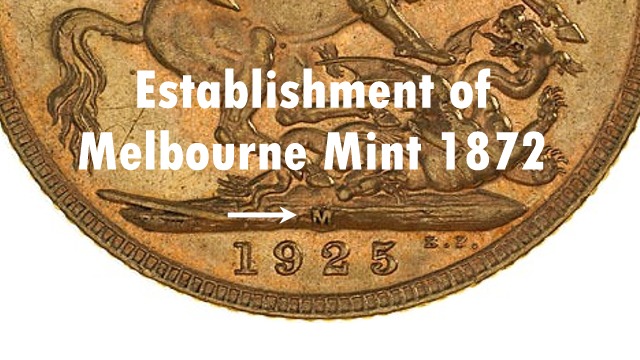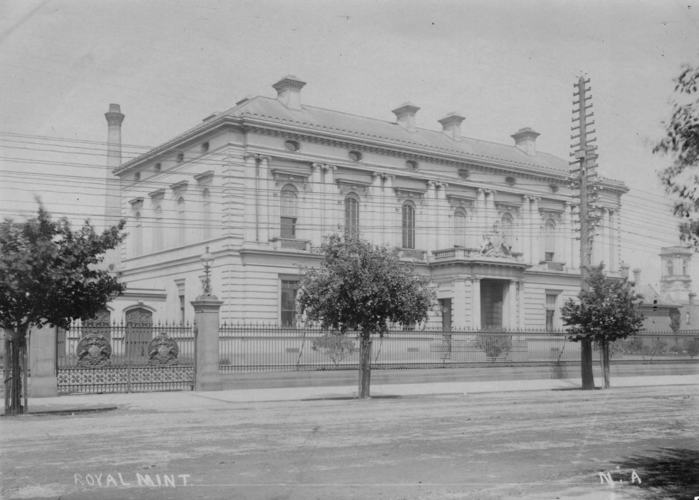
by Mr John Sharples, Curator Emeritus at Museums Victoria
The discovery of gold in Victoria in 1851 occurred at a time when the colony used British Imperial coins. Prime among these coins was the gold sovereign, a coin of international repute whose gold content fixed the value of the pound. These gold coins were made at the Royal Mint in London – gold taken to the mint would be returned without charge in gold coins which were legal tender without limit. The gold being discovered in Australia could therefore be turned into money once it got to London. This was a problem for the diggers – they wanted to dig for more gold, not spend a year travelling to and from London by sailing ship.
The government saw this predicament and in July 1852 the Legislative Council petitioned Queen Victoria to establish a branch of the Royal Mint in Melbourne so that the gold could be turned into money in the colony. The petition was rejected although the need was understood; Sydney would have the first Australian Branch in 1855.
This simplified matters but did not remove the problem of transporting and insuring gold, even if only to Sydney, and Victoria was where most of the gold was being found. In 1865 a further petition was sent to the Queen, and it was successful. On 6 September 1867 the Victorian Mint Act (31 Vict. No.307) was passed by the Victorian Parliament. As required by London, it specified that “there shall be payable to Her Majesty out of the consolidated revenue of Victoria the sum or sums for defraying the salaries, contingencies retiring and other allowances and other expenses of the Melbourne Mint” and “all sums by way of fees and charges shall be paid over by the Deputy Master to the Treasurer of Victoria”.
To qualify to strike British gold coins the Melbourne Mint had to be a part of the British Royal Mint with its personnel under firm British control. The Chancellor of the Exchequer was the warden of the Royal Mint and its overseas branches and the British Treasury had the right to hire, promote, suspend and remove all workers. All dies used to strike the coins would be made in London to ensure the quality of the internationally recognised coin was retained. Samples of all coins produced would be sent to London to be included in the annual Trial of the Pyx, where their weight and gold content were tested against the legal standard.
The mint was to occupy a site on the corner of Williams and La Trobe streets, the site of the original Victorian Exhibition Building of 1854. There were originally four structures built around a square – on the north, the melting department; on the south, the assay department, on the east the coining department and on the west, administration. Only the administration building, which incorporated the Deputy Master’s residence, now survives.

The mint was opened on 12 June 1872 by the Governor and Viscountess Canterbury. This was somewhat later than planned; it had ordered and paid for dies to strike coins dated 1871. It was initially manned by volunteers from the Royal Engineers who had undertaken special training in London. They were under the command of Colonel Edward Ward who had already great experience with opening a mint in Australia; he had been in charge of the original team at the Sydney Mint in 1855.
Colonel Ward and P.F. Comber had arrived in Melbourne in 1869 to supervise the building of the mint. Comber, who had overseen the installation of the plant and machinery, became the first Superintendent of the Coining Department. Robert Barton, formally assayer to the Bank of England, and George Foord, a chemist and geologist with wide experience on the Victorian gold fields, became the first assayers.
Francis Bowyer Miller came from the Sydney Mint to be the first Clerk of the Bullion Office. In Sydney he had developed an industrial scale method for purifying gold, the Miller Process. This treatment was given to all gold that passed through the Melbourne Mint. Put simply, the raw gold was melted in a crucible. Firstly oxygen was passed through the molten metal to react with any lead it contained and then chlorine gas was pumped into the bottom of the crucible. The chlorine formed salts which were not soluble in the gold and could be scooped from the surface and later treated to recover the silver. The end result was gold that was 99.95% pure. To this copper was added to make the coinage alloy of 22 carat gold used for sovereign production.
For the first year security was provided by the Corps of Artillery. Those on duty were instructed to move about in a brisk and soldier-like manner preventing any idle or suspicious characters from loitering or committing a nuisance. Armed police were also stationed at the mint. One of the staff, Sapper Harris, was sent back to England in 1873 because he had run up too many debts in Melbourne and was judged a security risk. His main debts were doctor and funeral fees for his eight-year-old daughter. Six others, having trained local workmen, returned to England in 1875 and the balance remained in Melbourne.
In the first year of operation it processed 221,904 ounces of gold; its peak year was 1899 with 1,520,739 ounces. The production of gold coins ceased in 1931, the total issue of sovereigns being 147,283,131 and half-sovereigns 1,893,559.
Reference
Dyer, G.P. Royal Sovereign 1489-1989, Royal Mint Publications, 1989 chapter 4 “Sovereigns of the Overseas Branches”
Original article by Sharples, J. (2010) Establishment of Melbourne Mint, 1872 in Museums Victoria Collections . Text content of this article is licensed under a Creative Commons Attribution 4.0 International licence.
